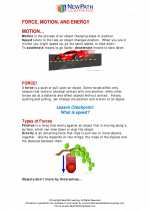Force, motion and energy -> newton's second law
Newton's Second Law of Motion
Newton's Second Law of Motion states that the force acting on an object is equal to the mass of the object multiplied by its acceleration. In mathematical terms, this can be expressed as:
F = ma
Where:
- F is the force applied to the object
- m is the mass of the object
- a is the acceleration of the object
This law explains how the velocity of an object changes when it is subjected to an external force. Simply put, the greater the force applied to an object, the greater the acceleration it will experience. Likewise, the greater the mass of the object, the smaller the acceleration for a given force.
Study Guide
Here are some key points to remember about Newton's Second Law of Motion:
- Force is directly proportional to acceleration: The force acting on an object is directly proportional to the acceleration it experiences. This means that if the force increases, the acceleration will also increase, and vice versa.
- Force is inversely proportional to mass: The force acting on an object is inversely proportional to the mass of the object. This means that if the mass increases, the acceleration will decrease for a given force, and vice versa.
- Units: The standard unit of force is the newton (N), the standard unit of mass is the kilogram (kg), and the standard unit of acceleration is meters per second squared (m/s2).
- Calculation: To calculate the force acting on an object, you can use the formula F = ma, where F is the force, m is the mass, and a is the acceleration.
- Real-world applications: Newton's Second Law of Motion is used in various real-world scenarios, such as calculating the force required to move an object, understanding the motion of vehicles, and predicting the behavior of projectiles.
Understanding Newton's Second Law of Motion is crucial in comprehending the behavior of objects in motion and the factors that influence their acceleration. It forms the basis for many concepts in physics and engineering.
[Newton's Second Law] Related Worksheets and Study Guides:
.◂Science Worksheets and Study Guides Fourth Grade. Force, motion and energy

 Activity Lesson
Activity Lesson
 Worksheet/Answer key
Worksheet/Answer key
 Worksheet/Answer key
Worksheet/Answer key
 Worksheet/Answer key
Worksheet/Answer key
 Worksheet/Answer key
Worksheet/Answer key
 Vocabulary/Answer key
Vocabulary/Answer key
 Vocabulary/Answer key
Vocabulary/Answer key
 Vocabulary/Answer key
Vocabulary/Answer key
